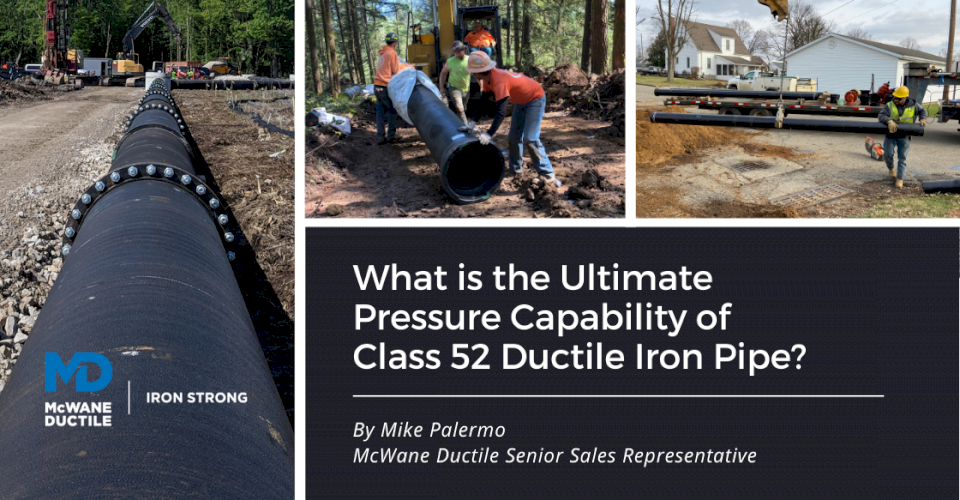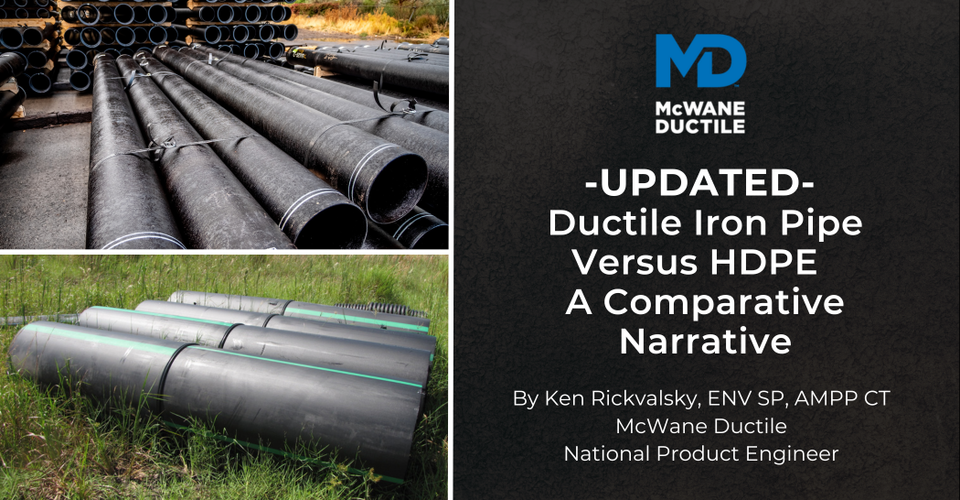-
What is the P2C Challenge? Preventing Pollution Before It Begins
06/04/2021 In Environmental & Safety Our CompanyJune 5 is World Environment Day sponsored by the United Nations. This observance is celebrated every year and aims to engage governments, businesses, and citizens to address pressing environmental issues. So, I felt it timely to discuss how McWane Inc. and its family of companies worldwide are committed to protecting the environment through proactive efforts and challenging employees to think outside the box.
-
What is the Ultimate Pressure Capability of Class 52 Ductile Iron Pipe?
05/21/2021 In Products TechnicalCast iron pipe was introduced to the United States in 1816. Since then, numerous other piping materials have been offered and utilized. None were able to supplant cast iron as the leading performer until Ductile iron pipe became available. The introduction of Ductile iron pipe (DI pipe) to the marketplace in 1955 remains among the most significant advancements in the history of the pressure pipe industry. It was quickly recognized as a pipe material with all the established durability of gray cast iron, yet with added strength and resiliency from its innate and lasting flexibility. It was first used for special and severe conditions of high pressure, such as where water hammer and excessive external loads might have existed.
-
What Are Common Installation Methods for Ball & Socket River Crossing Pipe and How is it Assembled?
05/14/2021 In Installation ProductsAs the name suggests, Ball & Socket River Crossing Pipe manufactured by McWane Ductile is a severe application Ductile iron pipe (DI pipe) product manufactured to meet the demanding requirements associated with crossing rivers, streams, and lakes. In this blog, we will discuss the various installation methods associated with Ball & Socket pipe and basic assembly instructions.
-
How to Use The McWane Pocket Engineer Volume Calculator – the First in a Series of 11
05/07/2021 In Products TechnicalIn recent years, an increasing number of locales and authorities have adopted greater controls of the water used in hydrostatic testing, flushing, and disinfection of utility pipelines, post-installation. Whether from a feeder hydrant to be metered, or when there might be a fee applied on the volume of water used, how does an engineer, contractor, or inspector compute the amount of water needed for these tasks? Sometimes it is required to demonstrate during flushing operations that the water inside a pipeline section has been “exchanged” a designated number of times during the specified flushing. So, just how much water does it take to fill or flush 1,500 feet of 12-inch class 52 DI pipe?
-
The Challenge of COVID-19 to the Water Utility Manager — Past, Present, and Future
04/28/2021 In Environmental & SafetyDuring the decades in which I have managed large and small water utilities throughout the country, I have experienced several challenging scenarios. Whether it was a major oil spill in the river that provided our raw water supply, a winter with sub-zero temperatures and no snow cover where small water mains were frozen solid in the ground, or the total transitioning from a groundwater source to a surface water source with all the different treatment methodology involved, I had never considered the terminology “the new normal.”
-
What Does Earth Day Mean to You as a Water Professional?
04/22/2021 In Environmental & Safety ProductsCelebrating Earth Day reminds us of the glorious surroundings we are provided with, bringing joy and happiness to our everyday lives. A variety of topographies span from rivers and streams to mountains and valleys. Even deserts and dry climate regions provide some of the most picturesque landscapes known to man. Earth Day is conveniently celebrated in the spring when flowers and trees burst with bountiful flowers and blooms. New life abounds as animals give birth to a new generation. A simple family picnic on a manicured lawn or trip down a mountain on a bike are just a couple of examples of pleasures we can enjoy.
-
Ductile Iron Pipe Weights - An Expanded Explanation
04/16/2021 In Products Services TechnicalThis article takes a deeper dive into concepts outlined in the July 2020 entry prepared by my co-worker Gary Gula, How Much Does Ductile Iron Pipe Weigh and Why Does It Matter to You? Specifically, we will focus on the pipe weight itself, answering questions such as: From where do these weights originate? Why do we show weights on each pipe? How trustworthy are these weights as provided? And, What do these weights mean to me, the pipe customer?
-
Ask the Ditch Doctor - Does the Direction of Ductile Iron Pipe Matter?
04/01/2021 In Installation ProductsHelp Me Ditch Doctor,
The inspector on this pipeline project came out here and just told us we are laying pipe in the wrong direction. He said the bells have to face the other direction like the plans show. He wants us to dig up the 1,000 feet of pipe we've already installed and reverse each pipe. Is he for real? Does it really matter?
-
Universal Land & McWane Ductile - A Relationship Spanning Generations
03/27/2021 In Our CompanyMcWane’s role as one of the world's most important suppliers of waterworks and monitoring products is based on fulfilling our responsibilities to our team members, our communities, and our customers. Our foundries produce products that deliver water and that last for generations.
-
What is the Purpose of Calcium Hypochlorite Granules?
03/20/2021 In Environmental & Safety TechnicalCalcium hypochlorite is an inorganic compound added in granular or tablet form added to water to kill germs that can make people sick. When used correctly, this compound destroys germs that can cause numerous health problems. ANSI/AWWA standard C651-14 incorporates essential procedures and requirements for the disinfection of new potable water mains. In this blog, we’ll cover why, when, and how it’s used in the waterworks industry.
Latest Posts
- Can Joining Water Works Industry Organizations Help You Grow Professionally? 10/21/2025 In Careers WaterWorks
- How Does Ductile Iron Pipe Provide Proven Resilience to Seismic Events? 09/04/2025 In Products Resiliency Technical
- How to Secure Green Reserve Sustainability Incentives Using State Revolving Funding & Ductile Iron Pipe 07/29/2025 In Energy Products Technical
- UPDATED - Ductile Iron Pipe Versus HDPE - A Comparative Narrative 05/29/2025 In Comparisons Products Technical















